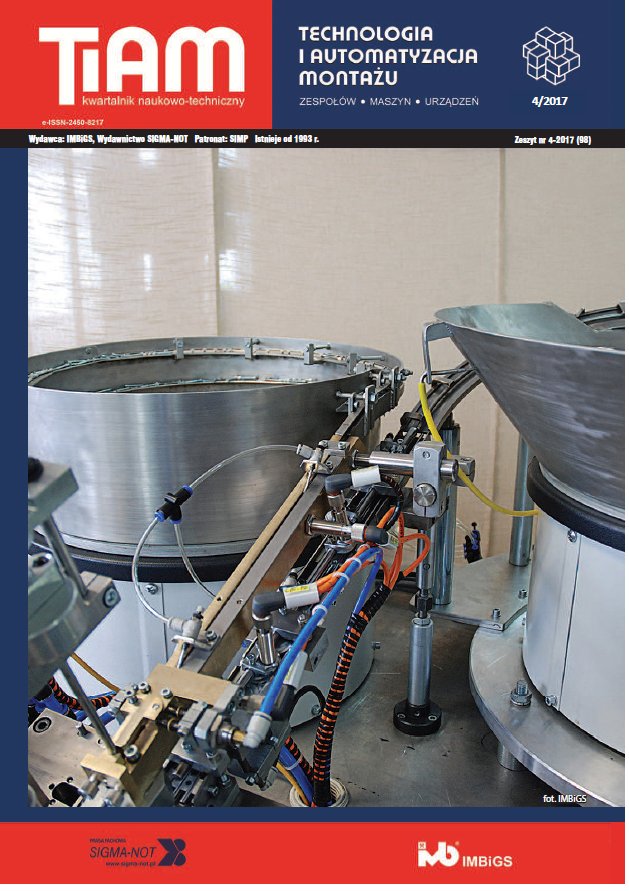Abstract
The paper presents results of a tensile test for adhesive, rivets and adhesive-riveted aluminum sheet EN AW-5754 joints. Values of strength and destructive force were presented. Due to its characteristics of used in research material finds application in almost all industries, precisely because the focus was on correctness of the technology made joints and the mechanical properties which characterized the resulting joints. Two of the most popular methods for performing permanent joints was used – bonding and riveting and hybrid of these two method. In riveting a single rivet made of an aluminum alloy was used. The holes for the rivets were previously drilled. In bonding process of the adhesive used was a two-component adhesive consisting of epoxy resin Epidian 57 and hardener PAC prepared in a stoichiometric ratio of 1:1. The sandpaper P320 machining process and degreasing with Loctite 7063 was used to surface treatment of surfaces adherends. The curing process was performed at ambient temperature. Analysed joints were destructive tested, in accordance with ISO 4587, on testing machine Zwick / Roell Z150.Based on the results observed that a better load capacity characterized by adhesive joints, but this result was similar with the load capacity of the joint adhesive-riveted. The least positive results were characterized by riveted joints, which could be due to the use of a single rivet.
This is an Open Access article distributed under the terms of the Creative Commons Attribution License CC BY 4.0 (https://creativecommons.org/licenses/by/4.0/)
References
Godzimirski J. 2009. „Problemy klejenia konstrukcyjnego”. Technologia i Automatyzacja Montażu (1): 25–31.
ISO 4587:2003 – Adhesives. Determination of tensile lap-shear strength of rigid-to-rigid bonded assemblies.
Kula W. 2005. „Projektowanie połączeń rozłącznych i nierozłącznych”. Radom: Instytut Technologii i Eksploatacji – Państwowy Instytut Badawczy.
Lachowicz M.M. i in. 2012. „Procesy zużycia tribologicznego, kawitacyjnego i korozyjnego wybranych stopów aluminium do przeróbki plastycznej”. Tribologia: tarcie, zużycie, smarowanie (5): 85–95.
Leśniak D. i in. 2016. „Wpływ zawartości Mg na własności mechaniczne kształtowników ze stopów aluminium serii 5xxx, wytwarzanych na drodze wyciskania zgrzewającego”. Rudy i Metale Nieżelazne Recykling (61): 248–253.
Maciołka P. 2010. „Wykorzystanie nośności powierzchni do uzyskania charakterystyki styku pomiędzy przedmiotem i ustalaczem połączenia”. Inżynieria Maszyn (15): 53–66.
Mucha J., W. Witkowski. 2011. „Nośność wybranych rozwiązań połączeń nitowych podczas próby ścinania i rozciągania”. Zeszyty Naukowe Politechniki Rzeszowskiej (4): 33–42.
Perłowski R. 2007. „Technologia i właściwości połączeń klejowo-nitowych”. Technologia i Automatyzacja Montażu (2): 124–127.
Rudawska A., M. Baziak. 2011. „Analiza porównawcza siły niszczącej połączenia klejowe, klejowo-nitowe oraz nitowe stopu tytanu”. Technologia i Automatyzacja Montażu (4): 40–44.
Rudawska A., T. Warda, P. Miłosz. 2015. „Wytrzymałość połączeń klejowych i nitowych”. Technologia i Automatyzacja Montażu (2): 56–59.
Rudawska A. 2009. „Wytrzymałość połączeń klejowych blach aluminiowych w aspekcie montażu połączeń nierozłącznych”. Technologia i Automatyzacja Montażu (2): 35–38.

